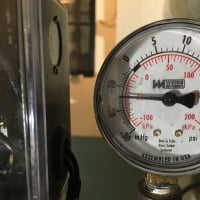Vacuum in a Wacky One-pipe, Two-pipe system
We have a steam system in a large 1882 building in Philadelphia. The building originally had a ducted gravity heating system. We think the steam system was a retrofit put in anytime between about 1910 and 1950. The 40 year old boiler collapsed about 2013 and was replaced by a company that - we discovered - really didn't know what they were doing. After much trial and error, we got things working reasonably well after about a year. However, it was never working great and then it started leaking in 2022 (dismissed by the company who installed it), and then badly in 2023 . So, it was rebuilt-by a different contractor. The contractors who rebuilt it were smarter. They have also proposed installing a condensate return tank because the system has had a troublesome vacuum issue all along that seems to be impeding heating. Seems like an okay idea - although a $$K idea. However, I've been thinking back to the original engineering. Again, this is an odd one-pipe, two-pipe system (so, the supply and return are co-mingled). There are NO steam traps. We do have Gorton vents at the ends of the three main branches. We also have Gorton valves on the radiators. No Vacuum breakers on the mains. I'm starting to wonder if the original design intended to utilize vacuum. In that case, subsequent changes may have botched that. How do we start figuring out how to work best with the original intention of the engineering, and how best to work with it. Do we undo past modifications. Or, do we push further, install the condensate return tank, steam traps and vacuum breakers to convert it more fully. I have gone through Dan's first book and can't find a piping diagram that seems to be quite like ours!
Comments
-
What do you mean by one pipe two pipe? It sounds like one pipe from your description so far.
Are there vents on the radiators?
Are there returns on the radiators?
A condensate tank would be for a system where some of the radiators are below the boiler or otherwise can't drain by gravity to the boiler or with a large amount of condensate. Residential systems rarely need a condensate tank.
Pictures of the boiler and piping and especially a radiator or 2 will tell us a lot.
1 -
You need a steam expert to sort through this.
I don't know who is in PA but you have several good people not that far away. In NJ you have @EzzyT , @clammy , @JohnNY and @Steamhead in Maryland.
Some of these consult if they don't work in your state and could maybe work with your existing contractor.
If the system never had a condensate pump why would it need one now?
I am not against them if needed but if you need something a boiler feed tank is a better choice.
Also check find a contractor on this site.
0 -
Have to agree w Ed ,add a condensate pump and they will be back adding a boiler feed pump . Usually you have a 2 pipe system and maybe over time some one slides in a single pipe cause they are clueless and it is much less work usually to fix other issue or band aide . Some two pipe system are designed to go into vacuum when the burner shuts of . This cannot occur w a single pipe system being for a single pipe system to operate it needs air vents with out there is no heat plus on the off cycle they will be sucking . If you are sure there are no traps on any of the two piped radiators then possibly your have a 2 pipe vapor system .If its going into vacuum it may be by design or it may be due to a few issue from uninsulated piping to recessed rads w zero insulation behind them to drastic air infiltration. Usually if a system never had a condensate or boiler feed pump then the system may not need the expense if it returning condensate by gravity . Possible over time the boiler water line was lowered and you lost some loop seals so they added f and t traps and then needed the other stuff to get water back in the boiler .Usually comes down to not enough b dimension . Most of that stuff can be square away w false water lines and a vaporstat and some one who has a idea not the clueless . Those w a clue tend to ty to let nature do it work ,there's nothing to break on a loop seal except get clogged overtime w mud unlike pump seals,motors and floats which do fail usually on a coldest day of the year and sals and motors are not cheap .
I have had system that are 2 pipe no trap systems that where band aided w condensate pumps and boiler feed pump which where completely unnecessary . After drastic reworking they still have them and the system runs at only a few ounces and when either one finally give up the ghost ,i 'll be hopefully that owner does the true update and does a gravity return and install some hoffmann 67 vacuum vents at the ends of the returns and mains and truly starts saving some money . It s not that every 2 pipe system is a vapor /vacuum but a 2 pipe w no traps is a candid in my book but some one w a clue has to really give the whole system a look over and it would never happen w a single pipe system .
peace and good luck clammy
R.A. Calmbacher L.L.C. HVAC
NJ Master HVAC Lic.
Mahwah, NJ
Specializing in steam and hydronic heating0 -
Any chance this could have been a Paul air line system?
Please tell us more about air vents on mains and radiators, also traps on the return lines.
Dennis Pataki. Former Service Manager and Heating Pump Product Manager for Nash Engineering Company. Phone: 1-888 853 9963
Website: www.nashjenningspumps.com
The first step in solving any problem is TO IDENTIFY THE PROBLEM.0 -
This system has puzzled me to no end for 10 years. Then I got to Chapter 15 of The Lost Art of Steam Heating. Aha. We're somewhere in that chapter. Some of the radiators are one pipe, with no separate return leg. Some of the radiators are two pipe. There are other things that are even a bit stranger. What I've definitely figured out, and confirmed by chapter 15, is that this was originally intended to be a low pressure system. Every tech who's ever worked on it has urged me to run it at 2PSI or me. That's wrong! It's happiest at a little over 1 PSI. I think that may even go lower as I fiddle with (i.e., experiment with lowering) the cut in pressure). I think that we do have some vacuum issues, and have experimented in that realm with some Danfoss RA2000 where I think that vacuum might be an issue instead of an aid. Still experimenting with that. I have told our very lovely vintage contractor that I am setting aside the condensate return tank/pump idea for now. I also sent him a copy of The Lost Art and he loves it. I think he's agreeing with me now, too. In the background, I dug out the old air vents that were on the radiators when we got the building in 2008 (because why would I ever throw anything away?). I've replaced them with various Gortons. The old valves (probably the original valves) were Dole No. 3 Patent Pending valves - dating to beween 1926 and 1930. This further presses the chapter 15 idea. I think the building was upgraded in the late 1920s from a coal gravity system with ductwork, to the one pipe/two pipe combination steam system that people were experimenting with during this time period. I think the next issue will be whether to install any traps, or not. And, yes, Mr. Steamhead is likely to get a call from me when I figure out how to do that (thanks for the suggestions). Here's the Dole air vent schematic: https://patentimages.storage.googleapis.com/87/92/0b/1e70583ac88b91/US1778612-drawings-page-1.png
0 -
if you understand where steam and air and condensate need to go it is possible to combine 1 pipe and 2 pipe radiators on the same system. either it was someone that understood steam very well or not at all.
there was a 2 pipe air vent system. the returns needed to more or less individually connect below the water line.
0
Categories
- All Categories
- 87.3K THE MAIN WALL
- 3.2K A-C, Heat Pumps & Refrigeration
- 61 Biomass
- 429 Carbon Monoxide Awareness
- 120 Chimneys & Flues
- 2.1K Domestic Hot Water
- 5.8K Gas Heating
- 115 Geothermal
- 166 Indoor-Air Quality
- 3.7K Oil Heating
- 77 Pipe Deterioration
- 1K Plumbing
- 6.5K Radiant Heating
- 395 Solar
- 15.7K Strictly Steam
- 3.4K Thermostats and Controls
- 56 Water Quality
- 51 Industry Classes
- 50 Job Opportunities
- 18 Recall Announcements

